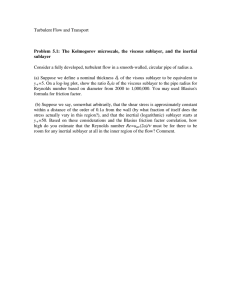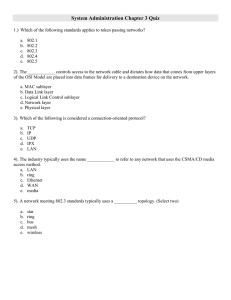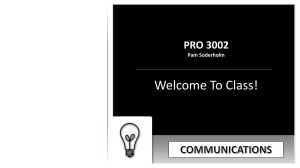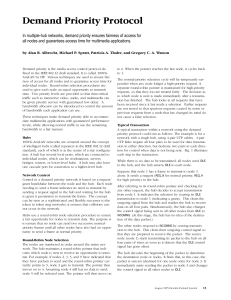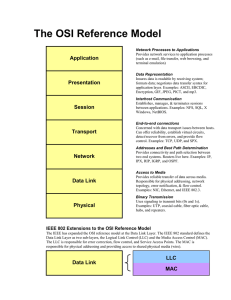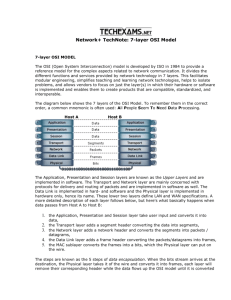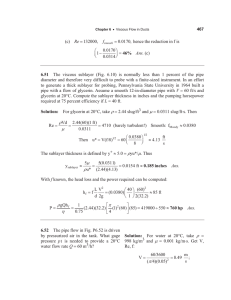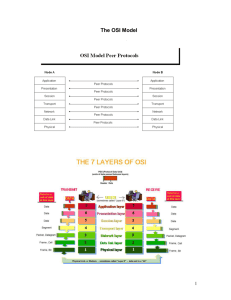Document 12969739
advertisement
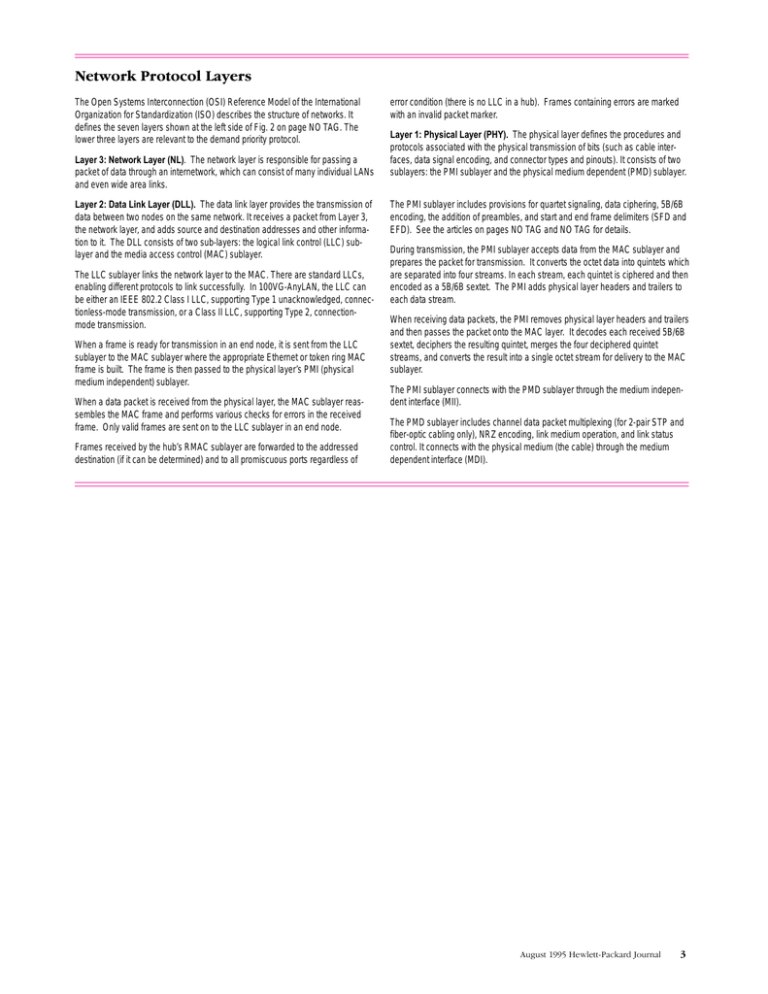
" The Open Systems Interconnection (OSI) Reference Model of the International Organization for Standardization (ISO) describes the structure of networks. It defines the seven layers shown at the left side of Fig. 2 on page NO TAG. The lower three layers are relevant to the demand priority protocol. Layer 3: Network Layer (NL). The network layer is responsible for passing a packet of data through an internetwork, which can consist of many individual LANs and even wide area links. Layer 2: Data Link Layer (DLL). The data link layer provides the transmission of data between two nodes on the same network. It receives a packet from Layer 3, the network layer, and adds source and destination addresses and other information to it. The DLL consists of two sub-layers: the logical link control (LLC) sublayer and the media access control (MAC) sublayer. The LLC sublayer links the network layer to the MAC. There are standard LLCs, enabling different protocols to link successfully. In 100VG-AnyLAN, the LLC can be either an IEEE 802.2 Class I LLC, supporting Type 1 unacknowledged, connectionless-mode transmission, or a Class II LLC, supporting Type 2, connectionmode transmission. When a frame is ready for transmission in an end node, it is sent from the LLC sublayer to the MAC sublayer where the appropriate Ethernet or token ring MAC frame is built. The frame is then passed to the physical layer’s PMI (physical medium independent) sublayer. When a data packet is received from the physical layer, the MAC sublayer reassembles the MAC frame and performs various checks for errors in the received frame. Only valid frames are sent on to the LLC sublayer in an end node. Frames received by the hub’s RMAC sublayer are forwarded to the addressed destination (if it can be determined) and to all promiscuous ports regardless of #$ &#, ,-"# $'012 (-',1 2&# ,#25-0) &,"1&)# 20',',% 1#/3#,!# -!!301 #25##, '2 ," 2&# &3 "30',% 5&'!& 2&# ,-"# 1#,"1 2&# &3 '21 9 '2 ""0#11 2 *1- 1#,"1 -2&#0 ',$-0+2'-, 13!& 1 5&2 27.# -$ $0+# '2 5'** 31# -0 ," '$ '2 5,21 2- 0#!#'4# ** .!)9 #21 -$ "2 5&#2&#0 ""0#11#" 2- '2 -0 ,-2 .0-+'1!3-31 +-"# &# &3 !!#.21 -0 0#(#!21 2&'1 ',$-0+2'-, -0 #69 +.*# 2&# &3 +'%&2 # !-,$'%30#" 7 2&# ,#25-0) "+',9 '1202-0 2- 0#(#!2 .0-+'1!3-31 +-"# 2- .0#1#04# &'%& *#4#* -$ "2 .0'4!7 &# 25- .0'-0'27 *#4#*1 +)# '2 .-11' *# 2- %30,2## ,"9 5'"2& 2- ..*'!2'-,1 ," 2- )##. 2&# !!#11 "#*7 2&# 2'+# $-0 5&'!& ,-"#1 +7 &4# 2- 5'2 #$-0# #',% **-5#" 220,1+'2 5'2&', -3,"1 ,"5'"2& ," !!#11 "#*7 "#.#," -, 2&# 1'8# -$ 2&# ,#29 5-0) ," 2&# 57 '2 '1 !-,$'%30#" -"#1 31',% &'%&9.0'-0'27 20$$'! +7 ,##" 2- # !-,$'%30#" 1- 2&2 2&# +-3,2 -$ ,"5'"2& 2&#7 !, 31# '1 0#120'!2#" 32 ,-"#1 31',% -,*7 ,-0+*9.0'-0'27 20$$'! 5'** -.#02# 2-2**7 3,50# 2&2 &'%&9.0'-0'27 1#04'!# '1 #',% .0-4'"#" 2- -2&#0 ,-"#1 '2&-32 ,7 -2&#0 $-0+ -$ !-,20-* ,-"#1 5'1&',% 2- 1#," &'%&9.0'-0'27 20$$'! 5'** 32-+2'!**7 # **-5#" 2- 1#," , #/3* ,3+ #0 -$ &'%&9.0'-0'27 $0+#1 ,7 ,"5'"2& ,-2 31#" 7 2&'1 &'%&9.0'-0'27 20$$'! '1 2&#, 32-+2'!**7 1&0#" error condition (there is no LLC in a hub). Frames containing errors are marked with an invalid packet marker. Layer 1: Physical Layer (PHY). The physical layer defines the procedures and protocols associated with the physical transmission of bits (such as cable interfaces, data signal encoding, and connector types and pinouts). It consists of two sublayers: the PMI sublayer and the physical medium dependent (PMD) sublayer. The PMI sublayer includes provisions for quartet signaling, data ciphering, 5B/6B encoding, the addition of preambles, and start and end frame delimiters (SFD and EFD). See the articles on pages NO TAG and NO TAG for details. During transmission, the PMI sublayer accepts data from the MAC sublayer and prepares the packet for transmission. It converts the octet data into quintets which are separated into four streams. In each stream, each quintet is ciphered and then encoded as a 5B/6B sextet. The PMI adds physical layer headers and trailers to each data stream. When receiving data packets, the PMI removes physical layer headers and trailers and then passes the packet onto the MAC layer. It decodes each received 5B/6B sextet, deciphers the resulting quintet, merges the four deciphered quintet streams, and converts the result into a single octet stream for delivery to the MAC sublayer. The PMI sublayer connects with the PMD sublayer through the medium independent interface (MII). The PMD sublayer includes channel data packet multiplexing (for 2-pair STP and fiber-optic cabling only), NRZ encoding, link medium operation, and link status control. It connects with the physical medium (the cable) through the medium dependent interface (MDI). #25##, ** ,-"#1 5'1&',% 2- 1#," ,-0+*9.0'-0'27 20$$'! *#0*7 5&#0# 2&#0# '1 #6!#11'4# &'%&9.0'-0'27 20$$'! 2&# ,"5'"2& **-5#" $-0 &'%&9.0'-0'27 0#/3#121 ,##"1 2- # 0#120'!2#" ', 1-+# 57 1- 2&2 ,-0+*9.0'-0'27 20$$'! '1 ,#4#0 !-+.*#2#*7 12-..#" 71 -$ "-',% 2&'1 0# "#1!0' #" ', 2&# 02'!*# -, .%# " &# "#2#0+','12'! #&4'-0 -$ 2&# 0-3,"90- ', 1#*#!2'-, .0-9 !#"30# +#,1 2&2 '2 '1 #17 2- #12 *'1& 0#1-, *7 !!39 02# #12'+2# -$ 2&# +6'+3+ !!#11 "#*7 2&2 &'%&9.0'-09 '27 .!)#2 5'** #6.#0'#,!# -0 &3 5'2& , ,-"#1 31',% &'%&9.0'-0'27 20$$'! 2&# 5-0129!1# "#*7 5'** # , 5&#0# '1 2&# 2'+# '2 2)#1 2- 20,1+'2 2&# *0%#12 .-11' *# $0+# 2 '1 ,-2 , 1 +'%&2 # #6.#!2#" #!31# 2&# 5-012 !1# -!!301 5&#, &'%&9.0'-0'27 0#/3#12 '1 0#!#'4#" $0-+ ** ,-"#1 (312 2 2&# +-+#,2 5&#, 2&# &3 12021 2- 1#04'!# ,-0+*9.0'-0'27 0#/3#12 -0 #6+.*# 2&# 5-0129!1# "#*7 $-0 &3 5'2& ,-"#1 $-050"',% 9 72# $0+#1 '1 +1 -0 $-0 9 72# $0+#1 +1 !!#11 "#*7 $-0 ,-0+*9.0'-0'27 0#/3#12 '1 +-0# "'$$'!3*2 2!*!3*2# 32 2&# .#0$-0+,!# "2 .0#1#,2#" ', 2&# ,#62 1#!2'-, 1&-51 5&2 "#*71 +'%&2 # #6.#!2#" 3,"#0 &#47 *-" ! 0'-31 1'+3*2'-,1 &4# ##, 03, 2- #6+',# 2&# #$$#!2 -, &'%&9.0'-0'27 20$$'! 1 ,-0+*9.0'-0'27 20$$'! ',!0#1#1 !& 3%312 #5*#229!)0" -30,*
